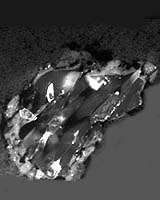This image shows a comet particle collected by NASA's Stardust spacecraft. The particle consists of the silicate mineral forsterite, also known as peridot in its gem form. It is surrounded by a thin rim of melted aerogel, the lightweight substance used to collect the comet dust samples. The particle is about 2 micrometers across.
NASA's Stardust spacecraft was launched on Feb. 7, 1999, from Cape Canaveral Air Station in Florida, aboard a Delta II rocket. It completed its primary goal to collect dust and carbon-based samples in January 2004, during its closest encounter with Comet Wild 2 (pronounced "Vilt 2"), named after its Swiss discoverer.
Stardust's capsule containing the samples parachuted safely to the Utah desert on Jan. 15, 2005, and the mission team transported the capsule to Johnson Space Center on Jan. 17. Since then, scientists have been extracting and examining comet-dust and potential interstellar-dust particles from the aerogel collector.
Copyright 2006 by Space Daily, Distributed United Press International
























